This post may contain affiliate links. Please see our disclosure policy.
Plokkfiskur is a traditional Icelandic dish made from fish, potatoes, onion and bechamel sauce. The result is thick and creamy comfort food that’s popular with locals and tourists alike.

In truth, plokkfiskur isn’t quiet a stew, at least not by modern standards. It’s a rich dish, with butter and cream similar to fish chowder, but the sauce is thick so that plokkfiskur is just as at home in a bowl or served as a spread on top of thin slices of Icelandic rye bread (rúgbrauð).
The recipe is similar to other Icelandic food staples, in that it’s based on meat/fish and potatoes, and it’s stick to your ribs comfort food. Kjötsúpa (Icelandic Lamb Soup), for example, uses lamb and skips the cream, but slow-cooked marrow bones add plenty of richness.
Simple to prepare meals, from high-quality ingredients are staples of Icelandic cuisine, and plokkfiskur is no exception.
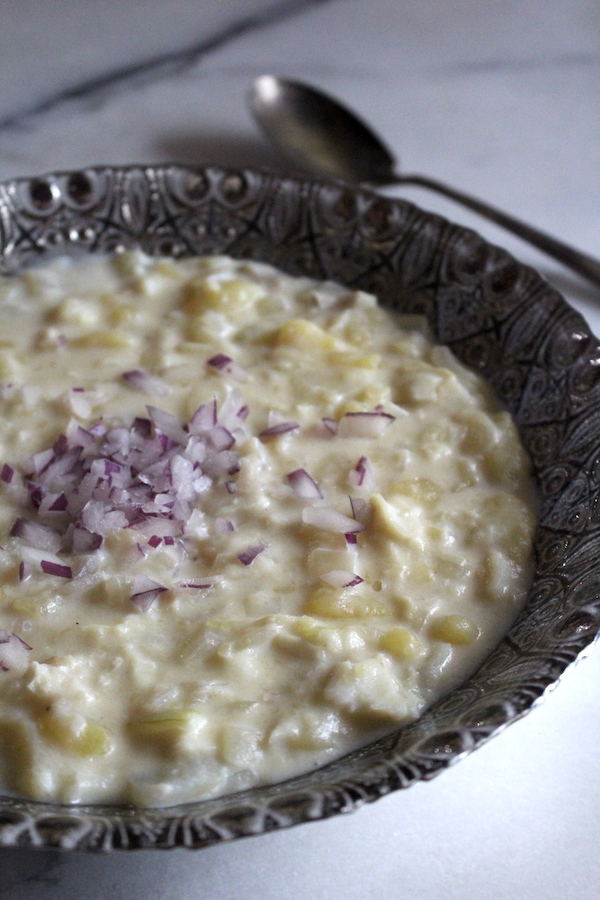
Ingredients for Icelandic Plokkfiskur
The most basic plokkfiskur starts simply with white fish (such as haddock or cod), potatoes, onion, flour, milk or cream, butter, salt, and pepper. The interesting thing though, is that both the fish and potatoes are cooked before going into the dish.
The recipe arose in part out of necessity, as a simple way to use leftover fish and potatoes, common ingredients in Icelandic cuisine. And practically speaking, it’s a good way to bulk out expensive cuts of fish with cheaper potatoes.
In Iceland, buying fish usually means buying a whole side rather than the small cut portions we’re accustomed to in the US. With that in mind, you can imagine how often you’d have leftover fish for making a quick homemade plokkfiskur.
This waste not, want not ethic is found in other traditional Icelandic dishes, such as Lemmur, or Icelandic oatmeal pancakes. These were invented as a way to use up leftover cooked oatmeal the following day, and simple though they are, lemmur are a huge hit with my kids.
Just because a recipe rose up out of necessity, doesn’t mean it’s not delicious.
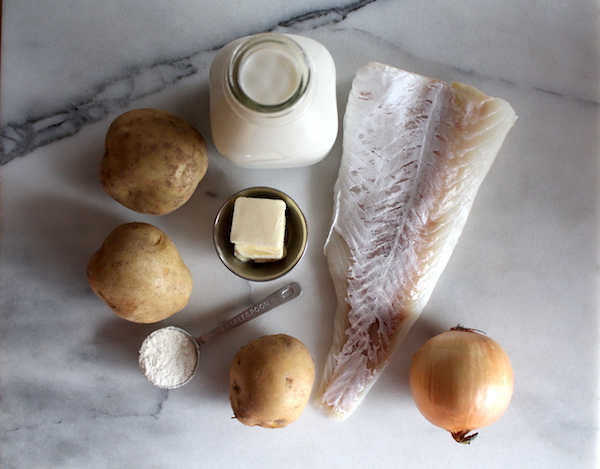
Plokkfiskur Variations
As with any dish central to a culture’s cuisine, every family seems to have their own recipe for plokkfiskur. Think of it like an old family recipe for baked mac and cheese, where just about anything fits into the creamy sauce. Everyone’s grandma has their own version, but no one complains regardless of the plokkfiskur variation set before them.
Some keep it simple, and stick to the dishes’ fish and potato roots. Others add curry powder to the sauce, turning the dish a brilliant yellow and adding a spicy kick. Others still turn the dish yellow, but with a bit of powdered mustard, which adds a milder spice and keeps the dish simple.
With all the creamy comfort food elements already at play, adding cheese is an obvious variation with delicious results. Something mild, that’ll melt well into the bechamel and not overwhelm the delicate flavor of the white fish.
Most commonly, plokkfiskur is made on the stovetop, but some modern variations make it as an oven-baked casserole topped with either cheese, or buttered breadcrumbs.
The Nordic Cookbook, one of my favorite cookbooks of all time, has an extended section discussing plokkfiskur variations:
“This is an ancient dish, which exists today in many variations. In the old days, I imagine it was made from salted and dried fish or just dried fish and the connection to central European dishes, like for example brandade, is quite apparent. Today, plokkfiskur is mostly made from fresh cod or haddock, which is boiled specifically for the dish, or else from leftovers from another recipe. Most older recipes contain some onion and pepper as the only flavorings, but recent recipes contain things like curry powder, dijon mustard, and grated cheese — Or pretty much anything that seems fitting and delicious.
…The texture of the finished dish depends on how much you stir everything together. Mor stirring results in a finer structure and denser texture. I prefer to stir just a little so that there are still some chunks of fish and potato left.”
The author, Magnus Nilsson, mentions that there are very similar dishes served in both Norway and Denmark. In Norway, it’s known as Plukkfisk, and it contains finely cut leeks (instead of onions) and is served topped with bacon or salt pork. In Denmark, it’s called Plukfisk, and the sauce has a spoonful or two of coarse grain mustard mixed in during cooking.

How to Make Plokkfiskur
If you’re not making this dish with leftover fish and potatoes, start by cooking the fish until just done, and boiling potatoes. Break the fish up into flakes. Peel and cube the cooked potatoes.
Melt butter in a saucepan, add finely chopped onion and cook until translucent (but not browned). Sprinkle flour over the butter/onion mixture, and allow it to cook for a few seconds until it begins to “bloom” or bubble vigorously in the oil. Then quickly add the milk or cream, and whisk until no lumps remain.
Allow the mixture to simmer for a few minutes, until it begins to thicken.
Add the fish, potatoes, salt, pepper and any other seasonings of your choice. Continue to heat until everything is warmed through, and then remove from heat.
Stir to break up the fish and potatoes into smaller pieces, if you choose, or not.
I’ve based this recipe on a combination of the plokkfiskur recipes presented in The Icelandic Cookbook and The Nordic Cookbook. While modern variations often use more fish, I’m using equal amounts of fish and potatoes to reflect the historical reality that fish is expensive, and traditional recipes would have used fish as more of a flavoring rather than the dominant ingredient (especially since they were likely using salt fish).
If you’d like more fish, use 1 1/2 pounds fish (instead of 1 lb) and reduce the potato amount from 1 pound to 1/2 pound.
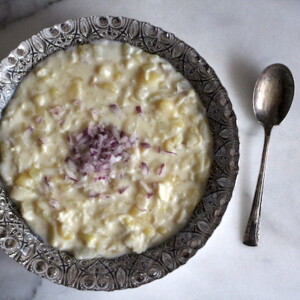
Icelandic Fish Stew (Plokkfiskur)
Ingredients
- 2 tbsp Butter
- 1 onion, finely chopped
- 1 tablespoon flour
- 2 1/2 cups 600 ml milk
- 1 lb 450g cooked white fish, such as cod or haddock, skinned, boned and broken into pieces
- 1 lb 450g potatoes, boiled, peeled and cut into cubes
- Salt and Pepper to Taste
Instructions
- Cook fish and potatoes if they're not already cooked. Break the fish up into flakes. Peel and cube the cooked potatoes.
- Melt butter in a saucepan, add finely chopped onion and cook until translucent (but not browned). Sprinkle flour over the butter/onion mixture, and allow it to cook for a few seconds until it begins to "bloom" or bubble vigorously in the oil.
- Quickly add the milk or cream, and whisk until no lumps remain.
- Allow the mixture to simmer for a few minutes until it begins to thicken.
- Add the fish, potatoes, salt, and pepper. Heat until everything is warmed through, and then remove from heat.
- Stir to break up the fish and potatoes into smaller pieces, if you choose, or not.
- Serve with rye bread, or with sliced onions and cucumbers.
More Traditional Icelandic Recipes
Looking to bring a bit more Scandinavia to the dinner table? Read on…
- Icelandic Christmas Cake (Jólakaka)
- Icelandic Donuts (Kleina)
- Icelandic Pancakes (Pönnukökur)
- Icelandic Lamb Soup (Kjotsupa)
- Icelandic Oatmeal Pancakes (Lummur)
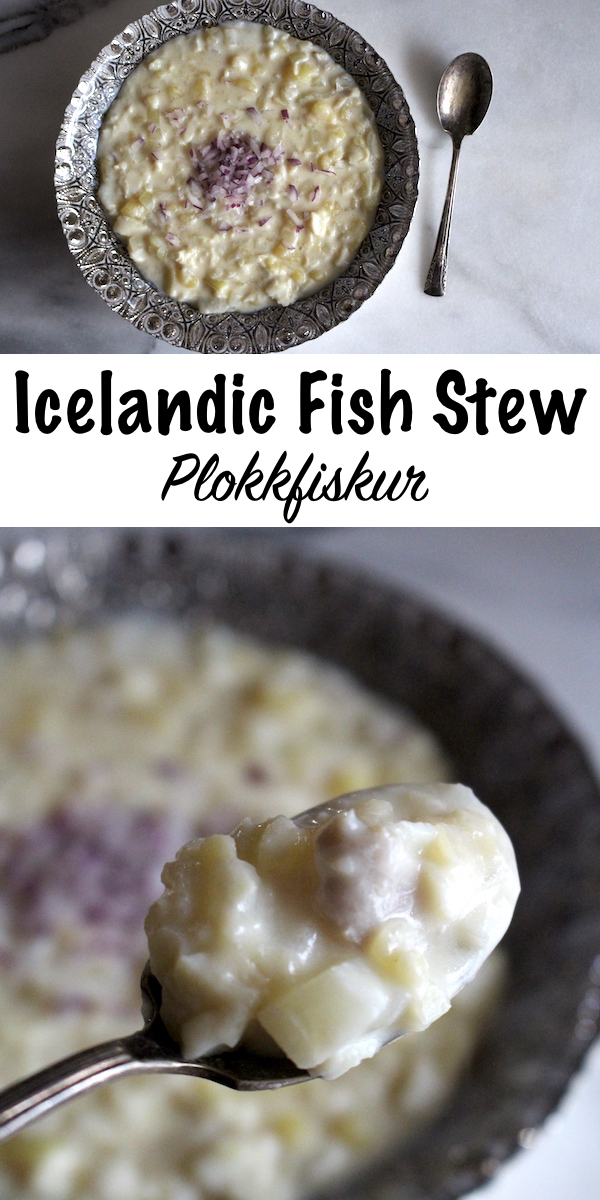



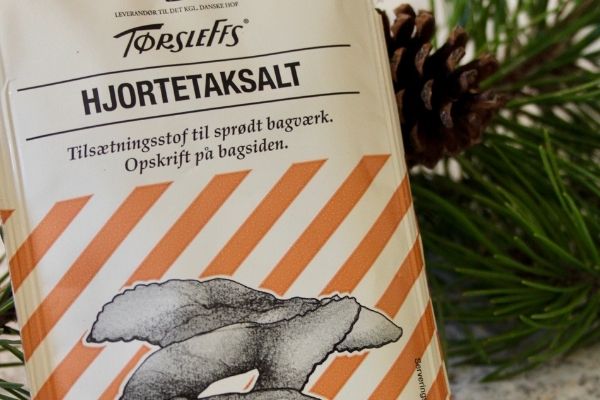
My mother used to make “codfish cakes” back in the 50s with dried codfish, soaked, and cooked potatoes. I wish I could find dried codfish so I could make it myself sometimes.
This recipe reminded me of them.
I had a fish stew when I was in Iceland and decided to try this recipe. Simple recipe, simple ingredients, great taste! I used halibut because it was what I had on hand. Not fishy and for someone who rarely cooks, I did well.